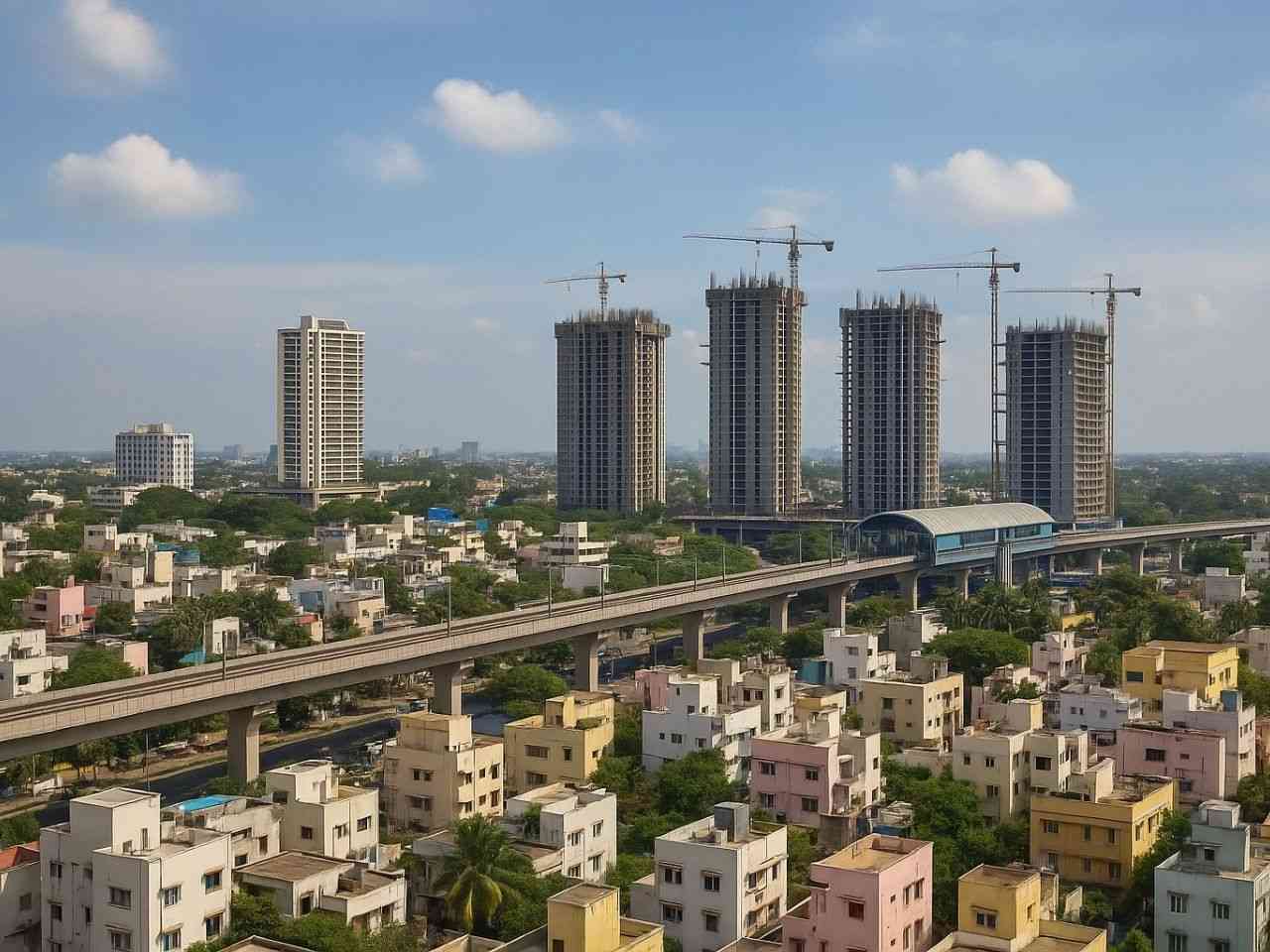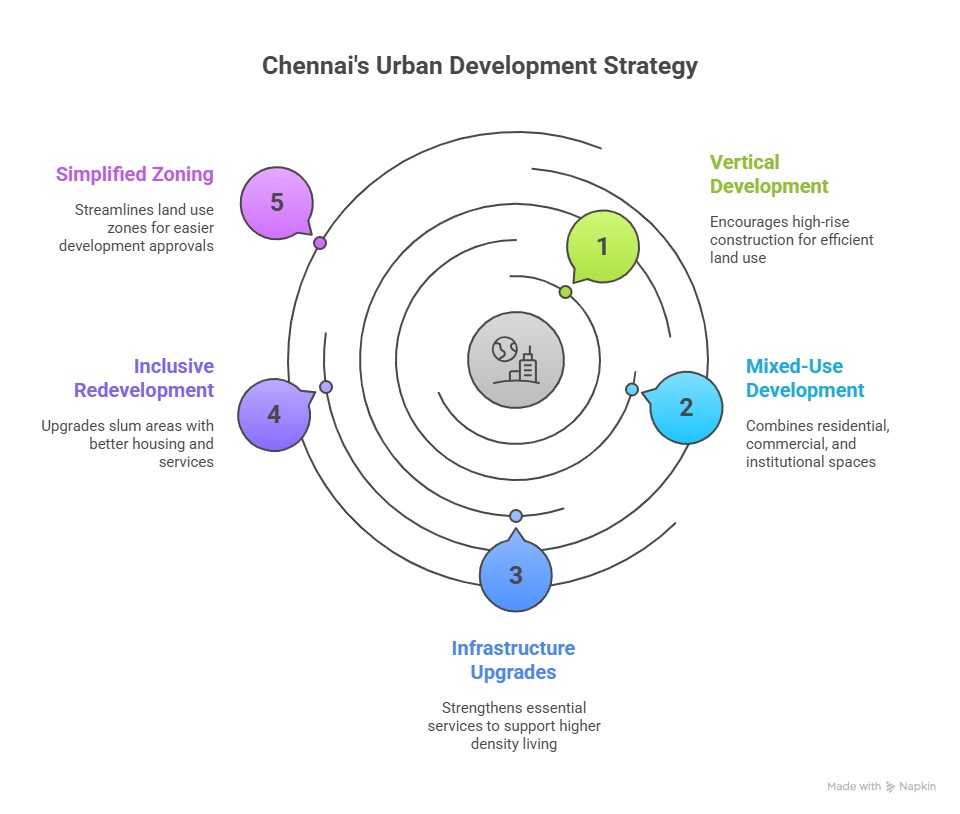
Chennai is changing, and this time, it’s reaching for the skies.
The Chennai Metropolitan Development Authority (CMDA) is working on its Third Master Plan (TMP), which will guide how the city grows and evolves over the next few decades. With a focus on vertical development, better use of land, and upgraded infrastructure, this plan could reshape how we live, commute, and invest in Chennai.
Whether you’re a first-time homebuyer, an investor, or someone simply curious about the city's future, here’s what you need to know.
CMDA is the authority responsible for planning how Chennai expands, from deciding where residential areas should come up, to how commercial zones are developed, to managing infrastructure like roads, sewage, and water supply.
The upcoming Third Master Plan covers 1,189 square kilometres of the Chennai Metropolitan Area and aims to guide development in a way that is more efficient, practical, and sustainable.
At the core of the plan is a key idea:
Instead of expanding outward, Chennai needs to grow vertically.
That means:
One of Chennai’s biggest challenges today is that people often live far from where they work or study. If you’ve ever spent over an hour commuting from Ambattur to T. Nagar, you already know the toll it takes.
By encouraging vertical development near transport hubs, office corridors, and commercial zones, the new plan aims to:
This shift also helps address rising housing demand by increasing the number of homes that can be built in high-potential areas, without expanding the city’s footprint.
A key feature of the new plan is the proposal to increase FSI (Floor Space Index) in selected areas. FSI determines how much built-up space is allowed on a given plot of land. A higher FSI means more floors and more usable space.
In practical terms, higher FSI allows developers to build taller buildings without needing more land. CMDA plans to raise FSI in places such as:
This move could make housing more accessible in well-connected, fast-developing areas, while also creating room for new offices, shops, and facilities. For buyers, this means more opportunities to explore apartments in Chennai with high FSI, especially in places like Guindy, Anna Nagar, and areas along metro corridors.
Traditionally, cities like Chennai have kept residential, commercial, and institutional zones separate. But that often leads to long commutes, traffic congestion, and underused spaces after business hours.
The Third Master Plan encourages mixed-use development, which allows a blend of:
Picture a modern apartment in Velachery, with a supermarket, co-working café, and preschool in the same complex, that’s the vision.
This model helps people live closer to everything they need, reduces traffic, and brings more energy to neighbourhoods throughout the day.
Taller buildings mean more people living in the same area. That’s good for saving space and cutting commute times, but it also puts extra pressure on the city’s basic systems.
If a high-rise apartment is built in a locality where the sewage lines, water pipelines, and roads were originally designed for just a handful of homes, you start running into problems.
For example:
That’s why CMDA isn’t just increasing FSI, they are also investing in phased upgrades to civic infrastructure.
Here’s what that would involve:
Each zone will be assessed based on how much development it can handle, and upgrades will be planned accordingly. The goal is to grow smart, not just fast, and to ensure quality of life improves along with growth.
A thoughtful part of the new plan focuses on in-situ redevelopment of Chennai’s informal settlements. Instead of relocating families far from their neighbourhoods, which often disrupts their jobs and schools, CMDA proposes improving housing right where these communities already live.
This includes:
This approach protects the social fabric of these communities while improving their quality of life.
Currently, Chennai’s land use map includes over ten different zoning categories, making it difficult and time-consuming to get approvals for real estate development.
The Third Master Plan aims to simplify this. Instead of many rigid zones, land will be classified into broader categories such as:
This makes the approval process faster, more transparent, and better aligned with how land is actually used by people. For real estate developers, this means fewer delays. For buyers, it means more choices.
For homebuyers, tenants, and investors, this plan brings real opportunities:
If you’ve been exploring properties in Madhavaram or looking for a flat in Avadi, this is a great time to take a closer look. Investing in Chennai suburbs like Ambattur and Chengalpattu are also expected to benefit directly from improved planning, upgraded infrastructure, and better connectivity under the new master plan.

A visual summary of the five key priorities shaping Chennai’s Third Master Plan for smarter, inclusive urban growth.
The Third Master Plan is not just a policy document, it’s a signal that Chennai is ready to grow in a smarter, more inclusive way.
By focusing on vertical growth, stronger infrastructure, and better zoning, the city is preparing to meet the needs of modern residents while also ensuring long-term sustainability.
For real estate buyers, this is a chance to invest in a Chennai that’s not just expanding, but evolving.
![]()